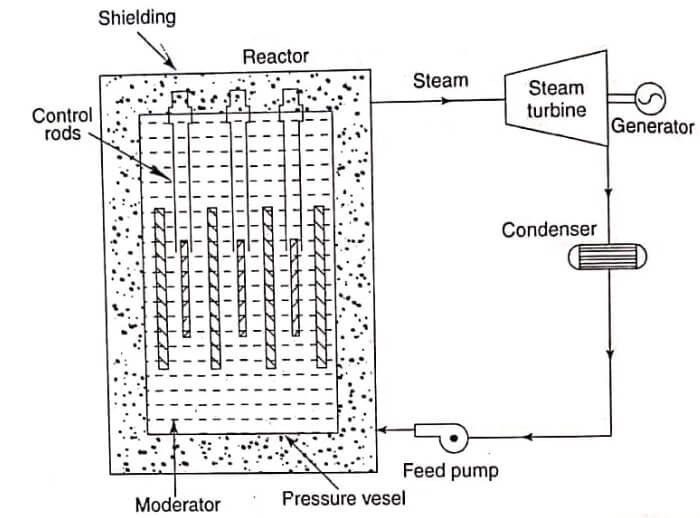The arrangement of boiling water reactor is simple when compared to the pressurised water reactor. The nuclear power plant using boiling water reactor is shown in fig. In this type of reactor also, enriched uranium is used as a fuel and water is used as a moderator, coolant and reflector in PWR. Only difference between PWR and BWR is that in a B.W.R, the steam is generated in the reactor itself instead of a separate steam generator.
Water enters the reactor at the bottom. This water is heated by the heat released due to this fission of fuel and gets converted into steam. The steam which leaves from the top of the reactor is passed through the turbine and expanded.
Exhaust steam from the turbine passes through the condenser and condensed. The condensed water is again recirculated again by using feed pump. India’s first nuclear power plant at Tarapur has two B.W.R.S of 200MW capacity each.
Advantages:
- Some intermediate heat exchange equipment eliminated.
- The reactor vessel is much lighter than PWR since the pressure inside the reactor is small.
- There is no heat exchanger, pressuriser and circulating pump. This reduces cost of the plant.
- Thermal efficiency of BWR plant is more (30%) than a PWR plant (20%).
- The metal temperature remains low for given output condition.
- Pressure is lower for given steam output conditions than in pressurized water reactor.
- BWR. is a self-controlled reactor as the reactivity is automatically reduced, if the vapour is not dense to moderate the neutrons effectively.
- A BWR is more stable than PWR and much stable than any other type of reactor.
- Power excursion quickly damped by formation of steam.
- Overall thermal efficiency quite high.
- Water is cheap.
- Core is compact if void coefficient is low.
- Negative temperature coefficient.
- Ordinary leakage can be tolerated.
- Fission products are contained not circulated.
- Radioactivity of coolant is short-lived if kept pure.
- Conversion ratio may be high.
- Heat may be taken from circulating water increasing power output.
Disadvantages:
- The steam entering the turbine is slightly radioactive. Hence, shielding of turbine and piping are needed.
- Wastage of steam resulting in lowering of thermal efficiency on part load operation.
- Lower power density (33.6kW/litre) and large in size.
- Power demand fluctuations cannot be met.
- Changes in load on turbine reflected back to reactor as pressure changes.
- Separately fired superheater cannot conveniently be employed.
- System must be designed to overcome tendency to react negatively to load increases.
- Fuel must be at least slightly enriched.
- Fuel handling necessitates complex equipments.
- Reactor must be shut down to unload and reload core.
- Water flashes to steam in case of rupture of primary system.
- Condenser leak may cause serious trouble.
| Read More Topics |
| Pressurised Water Reactor (PWR) |
| Canada Deuterium Uranium Reactor |
| Methods of Voltage control |






